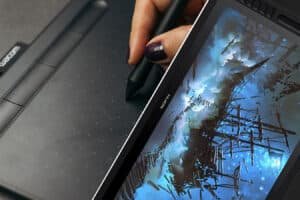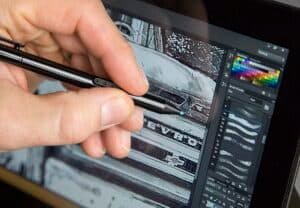You think of an alphabet/shape/Design, swirl with your fingertips or a stylus, and it magically appears on the screen. You didn’t use any actual ink or color yet it appears exactly, and it doesn’t transfer to your hand either. How does that happen? What makes digital drawing even possible? From the point when the stylus touches the screen till you see the results, the science involved behind the screen is often overlooked.
A drawing tablet sometimes referred to as a graphics tablet accurately transmits the strokes/movements from a pen or stylus to your computer screen. It translates your input and converts it into a digital output. Whether you want to paint, illustrate, animate in 3D, make a comic, retouch images, or just randomly scribble notes; a drawing tablet provides a more natural and comfortable feel than that of a mouse or touchpad.

Table of Contents
Drawing or graphics?
However, even though drawing tablets are also called graphic tablets, there is a difference between them. It’s important to be familiar with the difference between the two so that the basic working of the same is easier to grasp.
Typically, pen tablets are often referred to as “graphic” or “drawing” tablets by artists. Both are portable tools that allow you to express yourself in more ways than just with paint and pencils. Their purpose is the same. However, the difference lies as Graphics tablets are without screens. These are merely interactive pads with digital pens that function as mice and have additional buttons.
You cannot work on them independently. Graphic Tablets must be connected to a pc/laptop externally. You can then view your work on the display of your computer to see it. Wacom Intuos Pro and Huion Inspiroy Q11K are some examples of graphic tablets.
On the other hand, drawing tablets include real touch screens that function as extensions of the display on your PC. A pen display acts as both an input device and a monitor. Similar to the Huion and Wacom Cintiq 22. You can work on the screen of a Drawing Tablet independently without needing a computer. Both lack storage, necessitating connection to other hardware, but a drawing tablet allows you to sketch and display your work on the same surface, avoiding hassle.
Well, for me, drawing tablets or pen displays are the winners. Simply because it possesses some valid advantages. Drawing on a pen display has the same feel as drawing on paper, which I’d say is its principal benefit. As you carry out your regular tasks, the tablet’s screen displays every adjustment and modification as your design or piece of artwork is converted into a digital format.
Another big benefit of using a pen display is portability. It will allow you to draw anywhere, at any time, without requiring a computer or a larger display to see what you’re doing.
But! A drawing tablet alone doesn’t do wonders. There’s more. Read on.
Three essential components- For the digital drawing experience:-
It is essential to familiarise oneself with their parts to comprehend how they operate. A stylus or pen plus a drawing surface or tablet are complimentary to each other. When I say, I have a drawing tablet, it is automatically understood that I also have a pen or stylus along with it. Both of these are just requisites that enable you to access software. The software is what lets you work or draw. That is how it appears at a glimpse, but let’s explore the wider picture and understand the technicalities.
1-Understanding the drawing tablet
The tablet, which is the major part as we know, has a drawing space in the center and a few buttons placed usefully throughout its sides. Express Keys are the name for these buttons. There are ideally 8 to 16 keys on any drawing tablet, which can be utilized to quickly access essential settings and save time. You can also customize commands to these express keys and they will carry out the tasks assigned when you press them.
You may add shortcuts to zoom in, expand items, or erase your most recent brushstroke, for instance. This expedites the completion of your task and makes up for the lack of a keyboard.

Your tablet must first be connected to your PC via a USB port before you can use it. The manufacturer’s drivers must then be installed to calibrate the tablet to respond to your commands. The act of drawing a line is converted into electromagnetic impulses that the tablet’s sensor board detects and gathers. If you have a drawing tablet, the image of what you’re sketching will be displayed on both the tablet surface and the monitor of your PC. With graphic tablets, however, you are limited to viewing your work on the PC’s screen.
When buying a tablet, their specifications are typically distinguished by their size, drawing area, resolution size (measured in lines per inch, or LPI), pressure sensitivity (the degree to which pressure can change the size of a stroke), number of buttons, and the types and number of interfaces they support, such as Bluetooth and USB. The size of the pen’s nib is important to note since it determines how accurate the drawing will be.
2-Understanding the Working of a Stylus
A stylus is an essential part of the digital drawing experience. It is a gadget that, technically speaking, functions as an extension of our fingertips and facilitates interaction with touch-screen displays.
The stylus not only improves pen control but also makes it possible to click more precisely in smaller spaces. In comparison to what our clumsy fingers might create, this makes it possible for you to draw and write tremendously better.
Well, a stylus can be differentiated into two categories: active and passive stylus. I’ll give you a headstart so that it becomes easier in choosing which suits your needs and is compatible with your drawing tablet.
An active stylus has a tip, just like a pen. However, it has electronic components inside. An active stylus is used by designers and painters because it offers greater accuracy and pressure sensitivity. It will occasionally have extra functions like memory or an eraser mode.

A passive stylus, sometimes known as a capacitive stylus, enables users to directly write and tap on screens. The gadget does not, however, receive inputs directly from the stylus.
It operates relatively simply compared to an active stylus. The passive stylus only transfers your finger’s electrical charge to the touch screen.
The fact that passive styluses function on all touch screens is a benefit of using one.
One does not have to spend money on buying several stylus pens for various operating systems, such as iOS or Android.
The digital pen, the second major component, is available in three different forms:
- Battery-powered,
- rechargeable, or
- based on electromagnetic resonance (EMR).
You most likely possess the last variety because it is the most recent technology and a common preference. EMR-based styluses function by absorbing waves from your tablet and converting them into electric energy, unlike the first two types, which rely solely on batteries. As a result, EMR styluses don’t require batteries or charging wires.
EMR Stylus employs several different methods, including electromagnetic wave detection, wireless transfer, and conversion.
These innovations prevent the EMR Styluses in drawing tablet from experiencing battery failure or wire breakage due to bends and twists. And while using these, this is by far my favorite part.
Here, the tablet’s surface’s job is to detect and receive electromagnetic waves.
A stylus is responsible for analyzing, accepting, and transferring the pressure data back to the tablet for additional analysis.
Your tablet will typically only respond to the tip of your pen as an input device, according to its intended use. The touchscreen receives digital signals that are translated into drawings on the screen when you move your stylus across the writing or drawing surface.
Stylus devices, like tablets, feature programmable/shortcut buttons that can be used for a variety of purposes. However, its size allows for only one or two of them. I would suggest using one button as an eraser and the other as the right mouse click would be the most practical configuration. However, the decision is always yours, depending on your need and style of work.
The pen is multi-purpose and can be used for more than just drawing; it fulfills the need for a mouse on a tablet. The pointer, for instance, displays where your pen is on the tablet screen when you move over it. Additionally, you may tap or drag and drop objects about the display using it.
3. Install/Use the pre-installed software you want to work on
Having owned a good drawing tablet and stylus, finally, you need software to start producing genuine art. Typically, the tablet you buy will either have a CD included or provide a free software download on its official website. The software provided freely depends on the company of the tablet bought.
You have a lot of free options to select from for beginners if you find the software on your tablet to be unsatisfactory or if the model doesn’t come with an app of your choice in the first place. Let me help you by proposing ArtRage and Krita for newcomer digital artists. Both have user-friendly interfaces with a variety of tools and brushes that mimic the look and feel of natural media. These are the most sought-after by newbie digital artists.

Adobe Illustrator is no doubt a great place to start if you’re more into vector art. A user-friendly and preferred program for artists who own Wacom tablets is Bamboo Paper.
Overall, it makes sense to test out multiple apps before choosing the one that works for you. Before you click the download option, just check sure the software is compatible with your tablet model and is from a safe website and you’re good to go!
How do Drawing Tablets work?
First, every user/potential buyer needs to understand how your drawing tablet operates. Only then can we take advantage of all of its potential and this is exactly why I’m writing this here to help. So if you continue reading and understanding along, I guarantee that you will be able to unpack your new tablet and get to work as soon as this article is done away with.
By now it’s clear that, unlike the tablets which have one surface and let you watch on another, touchscreen tablets or drawing tablets on pen displays are the ones that turn the entire display into a writing surface, allowing users to engage directly with the screen.
Well, the tablet, under the screen is composed of a horizontal and vertical network of wires. This plays a vital role in the input and output process. The tablet’s vertical and horizontal wires serve as both transmitting and receiving coils. The tablet can transmit the lines to the active computer screen or display by using electromagnetic signals. This happens because an electromagnetic field is created around a coil of wire when an electric current flows through it.
What happens inside the stylus and Drawing Tablets that make it work?
- Electromagnetic resonance (EMR) is a technique that allows pen tablets’ battery-free stylus to be powered wirelessly by the tablet itself.
- There is a grid of parallel wires that transfers electromagnetic waves inside the tablet.
- A wire coil inside the stylus transforms electromagnetic waves into electrical energy.
- The coils’ electrical energy is then employed to measure button clicks and pen pressure.
Electromagnetic waves produced by the stylus’ coils are used to transmit the measured data back to the tablet. In short, a circuit in the stylus receives an electromagnetic signal produced by the tablet. When a signal is received, the stylus acts as an antenna to create a second electromagnetic field that “talks back” to the tablet. The pen might have a cord or be battery-operated.

The coil circuit transfers signal to the main circuit inside the stylus when a user draws a line with it. While the pressure-sensitive capacitor gauges the lines’ pressure, this calculates the total number of line lengths. The sensor board, a grid of wires inside the tablet, picks up the data signal that the stylus produces.
However, a voltage differential, or electric current, is induced in a coil of wire as the magnetic field changes. The pen makes use of the electromagnetic induction capability to generate an electric current and send data through EM waves to the tablet.
Wondering how you’re able to get your output on the exact place where you press the stylus on the screen? The tablet checks for new data (electromagnetic waves). The location of the tablet’s signal reception point is determined, and that is how the position tracking is done.
It accomplishes this with the aid of wires that are placed horizontally and vertically and which recognize the incoming signal from the stylus. The underlying circuitry aids in focusing the signal’s reception point.
Talking more about it, I’d like to summarise the whole operation of the drawing tablet into three processes that include:
- Transmitting electromagnetic pulses at a defined frequency.
- Measuring the sensitivity and directions
- Receiving and giving the output after analyzing the instructions received.
Talking more in terms of the technical aspect. The Transmission circuit is the foundation of everything. The transmission of EM waves by the drawing tablet happens to start with an oscillator built into the transmitter that produces a signal with a set frequency. Additional circuitry in the transmitter converts this continuous stream into a pulse signal as we call it. The selection circuit then distributes the signal to every wire on the x-axis and the y-axis once the signal has progressed through the connection switching circuit.
It becomes electromagnetic waves when it passes through the wire and it is then broadcast in all directions. The rear of the wire grid has an electromagnetic shield that deflects electromagnetic waves that are traveling in that direction. As a result of this, just the front, where it comes into touch with the stylus, emits EM or electromagnetic waves. The tablet becomes ready to receive the signal after the electromagnetic wave has been transmitted.
The transmission circuit is switched over to the reception circuit via the connection switching circuit.
Conclusion
As time goes on, drawing tablets become more and more common, particularly among those of us who work in the beautiful field of design.
Drawing tablets have several basic advantages, including the fact that the stylus doesn’t need batteries and that ink will never run out! The tablets are also available in a variety of sizes, from compact, more portable models to larger options for more serious designers. Adding to this is the benefit of size. Tablets, at least the smaller ones, are light and portable. They are simple to toss into a briefcase or bag.
Moreover, using a drawing tablet can greatly increase your efficiency, which is one of its biggest features. Drawing tablets use the idea of “absolute placement,” in which the stylus location on the tablet will appear in the precise location on the screen which gives the most accurate results.
Drawing tablets share the same components as graphics tablets in terms of parts. The touch screen, which takes the place of the pressure-sensitive drawing surface, is the only addition. In addition, the hotkeys are frequently touchscreen shortcuts rather than physical buttons. The same experts that use graphics tablets also utilize drawing tablets. Due to the additional quality of visibility, they are frequently referred to as the superior choice.
It requires commitment and willingness, even though it may seem simple. To start drawing on a drawing tablet, you don’t need to be particularly talented. You should be aware, though, that mastering the use of a drawing tablet and programs like Illustrator or Procreate takes a lot of effort and practice!
Ben Scott is a prominent technology journalist and reviewer, specializing in tablet devices. He is known for his comprehensive and unbiased reviews of tablets from various manufacturers.
With a deep understanding of tablet technology, including hardware components, operating systems, and software applications, Scott provides clear and informative reviews accessible to readers of all levels of technical expertise.
His attention to detail and in-depth analysis have earned him a loyal following of readers.


